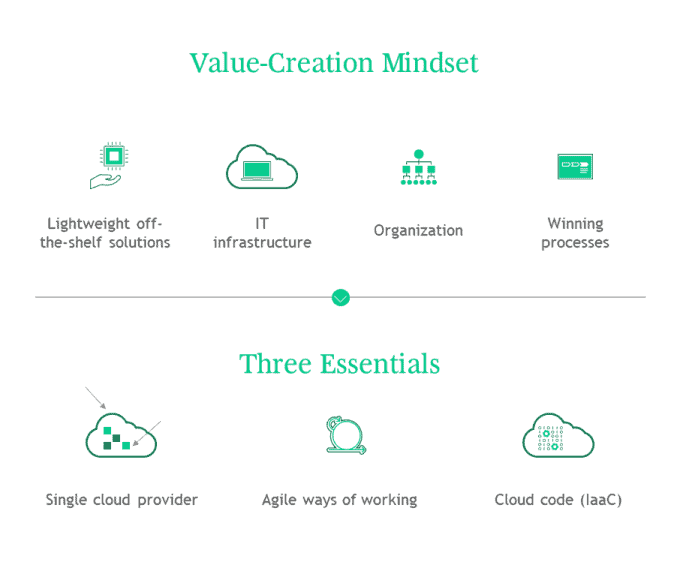While cloud computing is nowadays ubiquitous in the digital landscape, you may be surprised how essential it can be for entrepreneurs and startups in particular
Larger companies, lacking agility, have long struggled with cloud adoption due to cumbersome internal governance and compliance regulations. In contrast, digitally native start-ups which built their entire businesses on cloud-based IT infrastructures, quickly grew market share and outperformed established competitors. Prominent examples are Zoom, which everyone knows since the pandemic-induced work from home revolution, and N26, the most well-known digital natives bank in Germany.
The success of these nimble start-ups was so meteoric that big enterprises started to outsource digital solutions or develop new digital ventures in-house to create fresh value propositions or accelerate innovation cycles. Captive startups help companies attract digital talent and field-test new technology with minimized risk before rolling it out to the entire company. IT platforms of Soundcloud, Revolut and SwissRe’s IptiQ were built entirely on AWS despite existing on-premise or private cloud infrastructure.

So, if the largest companies have leaned into cloud-based IT, how can it still be an attractive solution for start-ups?
The answer requires an objective view on the new business landscape. A startup demands quite much from leaders to calibrate simultaneously: an exceptional idea to differentiate the brand; a solid business plan; expertise to execute the plan; and founding capital. This all requires and is enabled by the right IT strategy and infrastructure.
Leveraging established and leading cloud providers such as Amazon AWS, Microsoft Azure and Google Cloud Platform, startups can now build their entire IT function in the cloud with managed services. This empowers them to elastically scale their infrastructure when commercialization increases, without vast initial capital expenditure. This helps to turn your IT infrastructure into an enabler for business growth, instead of a cumbersome cost center.

“With the right strategy and rollout, a newly established company can reap the rewards of a lightweight, cloud-based approach to foundational IT infrastructure.”
" Annika Melchert, Senior IT ArchitectValue-Creation Mindset
Business leaders can benefit from a mindset shift toward utilizing managed services, simply by recognizing that for most IT infrastructure demands, “There’s a service for that.” Managed service options are augmented by a giant ecosystem of marketplace offers. The extensive scope of options means that most IT objectives can be achieved by combining various existing services to partially automate business support processes. This frees up CIOs’ time and energy to focus on core value propositions.
With the right strategy and rollout, a newly established company can reap the rewards of a lightweight, cloud-based approach to foundational IT infrastructure. Setup requires no more than a credit card, a few mouse clicks, and an internal advocate who is passionate about IT and cloud. This leader should be willing to explore the cloud marketplace and can quickly, easily and set up basic IT functionalities at relatively low cost.

This strong focus on value creation also applies to typically non-differentiating applications such as HR systems. Even systems that are part of current-day digital journeys, like financial accounting systems can often be treated as a commodity. In this light, non-customized SaaS services remain a reliable solution to achieve top-level efficiency and speed. Nevertheless, even the most value-focused mindset requires a strong foundation that new ideas and the business can be built on. Based on our experience, such a foundation consists of four pillars: lightweight off-the-shelf solutions, tailored IT infrastructure setup, agile organization, and winning processes.
Lightweight off-the-shelf solutions
Choosing the right lightweight, reliable, off-the-shelf services is one of the four pillars of a successful and true value-oriented digital strategy. These applications are a principle part of your employee’s daily work and absolutely essential for employees as well as customer satisfaction.
1. Identity management and email services to provide employees with credentials for all corporate services.
2. Virtual, cloud-based desktops to enable usage of private hardware in corporate environments.
3. Workplace and collaboration tools. Microsoft Office365, the de facto standard for large enterprises, and other cloud-based solutions like Google Drive, AWS Workdocs or Atlassian Confluence & Jira liberate small startups from software management on mobile end user devices.
4. Cloud based enterprise management systems are readily available from cloud marketplaces and help business support processes like Finance, HR and Payroll, ERP, or CRM to run smoothly.
IT Infrastructure
Besides the right lightweight off-the-shelf solutions, startups in particular can unlock greater value by integrating foundational cloud services into their custom developed applications. This ensures a state-of-the-art service setup while building a connection between “instant” capabilities and custom developed functionalities.
Organization
In order to optimally reflect the flexibility and scalability of infrastructure and technologies, a respective organization is key to unlock the full potential. With an agile organization that supports interdisciplinary, co-located teams, alignment effort can be reduced significantly, and value creation can be accelerated. The early integration of IT and business leads to optimized technological support and helps to build truly disruptive products. Even in the context of the latest pandemic, where close colocation is more of a challenge, several cloud-based collaboration tools foster online teamwork.
Winning Processes
Designing winning processes that are efficient and support the employee in its daily work, the fourth pillar of a successful and value generating digital strategy.
-
Cloud cost management services:
Keeping costs low is crucial for startups that are typically not as well funded as big companies. Alerts and budget setting in the cloud providers billing and cost management console instead of legacy approval processes accelerate implementation speed and provide operators all flexibility without the risk of surprising cost explosion.
-
DevSecOps:
In an agile organization, the ways of working need to follow these principles, too. Integrating security experts in the development process and putting developers in charge of operations reflects the agility requirements of today’s IT department.
-
Self-service mentality:
While a service-oriented approach is convenient for employees and especially appreciated by senior management, more self-service processes entail lower administrative effort, decreased cost and faster results. To enable a high degree of self-service processes, a solid governance framework must be applied.

Summary: Key Takeaways
While businesses embarking on their cloud journey are best positioned by using the full approach we’ve described above, these are the three essentials:
Nowadays, no business can succeed without digital infrastructure, which is why the benefits of cloud sourcing have become more and more compelling. While not long ago, new companies had to invest heavily into the purchase and build-out of legacy on-premise IT, infrastructure has become a commodity. So why not focusing on value creation to build exciting customer offerings instead of wasting time with enabling IT foundation?
“BCG Platinion has deep experience in digital strategies, plus planning and supporting cloud transformations. We work with leaders around the globe, driving the whole lifecycle from analyzing cloud options to execution.”
" Oliver Schwager, Managing DirectorAbout the Authors
Oliver Schwager
Managing DirectorMunich, Germany
Oliver is a Managing Director at BCG Platinion. He supports clients all around the globe when senior advice on ramping up and managing complex digital transformation initiatives is the key to success. With his extensive experience, he supports clients in their critical IT initiatives, ranging from designing and migrating to next-generation architectures up to transforming IT organizations to be ready for managing IT programs at scale in agile ways of working. He is part of the Industrial Goods leadership group with a passion for automotive & aviation.
Daniel Wagner
Former ManagerFrankfurt, Germany
Daniel is a highly experienced IT architecture and banking expert. Driven by his hands-on experience, he supports clients solving all kinds of challenging technology questions. Ranging from bringing cloud-based target architectures to life, over IT assessments to defining IT strategies as part of large-scale digital transformations.
Annika Melchert is a Principal at BCG Platinion based out of Dubai. She is leading the internal initiatives “Architecture Chapter” in Middle East as well as the “FinTech & Neobanking Group”. Driven by her passion for modern banking she worked with several fintechs and incumbent banks on their technology build, integration strategies, and digital transformations. Besides, she is hosting the “Fintech Files Podcast”.
Nico Clarner
ManagerMunich, Germany
Nico is an expert on enterprise-scale data architectures and data operationalization, especially on cloud service infrastructure. He has supported clients from different industries with IT strategy formulation, architecture design as well as conceptualization and steering of data-driven product development. Within the BCG Platinion architecture chapter, Nico is a core member of the cloud infrastructure team.


